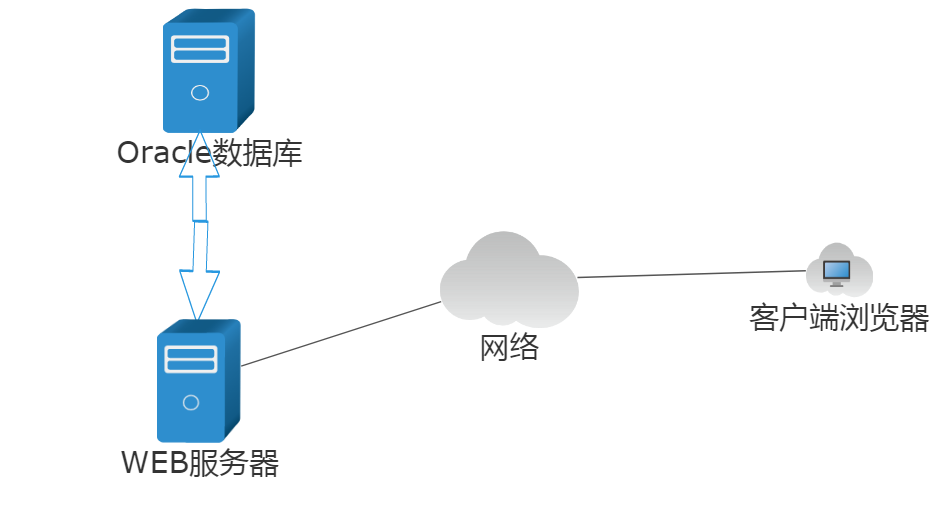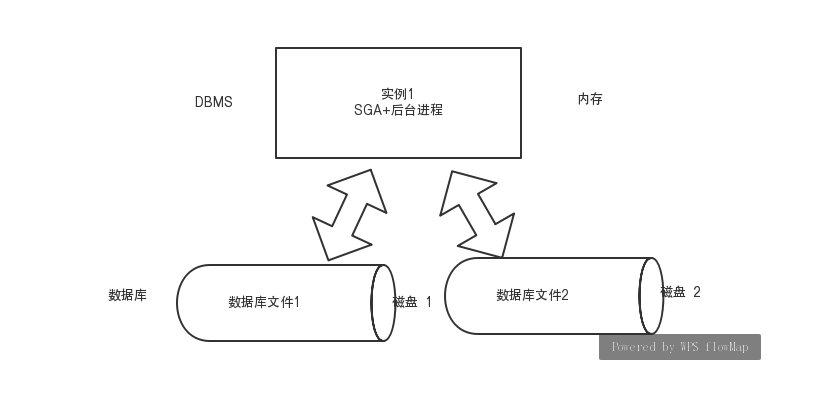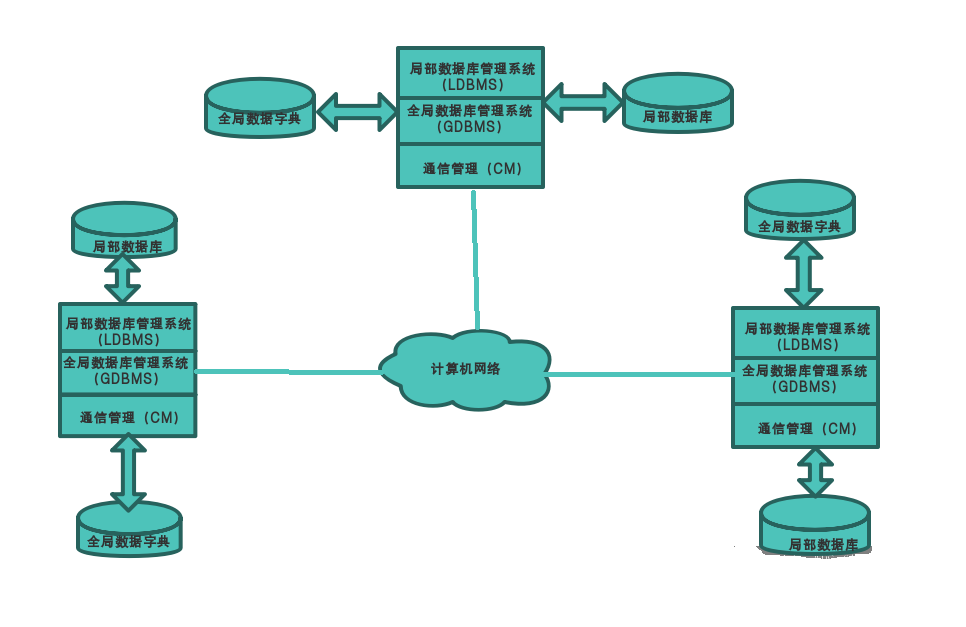When installing, deploying oracle database software, you need a different approach (basic installation, advanced installation) depending on the application structure (ie hardware platform, operating system platform), here are some common application structure.
1. Data Interface Application System
The client application requests a service or application server, it must first establish a connection to the database server and database. While existing DBMS almost all follow the SQL standard, but there are different manufacturers to develop DBMS differences, there are issues such as adaptability and portability, for which people research and development of a common method of connecting different DBMS, technology and software interfaces .
2. Client / Server (C / S) mode of application
In the C / S (cilent / server) configuration mode, all data is stored centrally on the server, data processing is performed by the server, the general hardware resources relatively high machine as a server, using configuration is relatively low PC as a client. Between the client and the server are connected through a dedicated network, usually a local area network or intranet.
FIG 2-1Oracle client / server architecture. Applications running on the client, Oracle database running connected together by a computer network between a server and two. Oracle uses SQL * NET communication between the client and the server.

FIG 1-2 Oracle client / server architecture
3.Oracle browser / server architecture
Oracle shown browser / server (B / S, Browser / Server) system is a three-layer structure shown in Figure 2-2. In the three-tier model B / S, the client application uses the WEB browser display, so the client also to customers hands,

Figure 2-2 Oracle Browser / Server three-tier architecture
The client that is browser did not load programs, deployed on a Web server, the client needs to load or browse data, first sends a request to the Web server through the network, Web server by requesting access to the Oracle database server and Web server in response to the data transfer displayed in the client.
B / S structure is non-connection oriented, i.e., establish access to the data connection is disconnected access end, to access data again needs to reestablish the connection, as compared with the C / S structure, its efficiency is low. Therefore, B / S is mainly used in operational efficiency is not critical to data released oriented environment.
4. The single-disk structure independent host
Single-disk structure is independent of the host simplest and most common configuration, the mechanism has only one computer, and a computer hard drive, here represented by the DBMS Oracle instance, the database indicates that the database file, shown in Figure 2-3:

Figure 2-3 Host independent single-disk structure
Note: The database server (also called instances), a set of background processes and memory structures to access the database files that make up.
This application architecture is only one database server (DBMS), a database file (database structure), and these data files are stored in a room on the disk, which is the most basic application structure, other structures are applied on the basis of modified and extended.
This structure will all database files are stored on a hard disk, a higher reliability requirements on the hardware, the direction of view of performance tuning is mainly to reduce the number of access to the database file.
The multi-disk structure independent of the host
Multi-disk structure only a separate host computer, but the computer by using a plurality of hard disks, 2-4:

FIG. 2-4 independent host multi-disk structure
This structure has only one database server, a database structure, but the database is stored in a plurality of physical disks, the files stored in a separate database to reduce the number of connections, but also reduces the read and write operations of the database file.
If disk mirroring (RAID technology, redundant array of independent disks technology) on these disks, all database files on each drive has a complete backup of any hard disk fails, it can work in place of a mirrored disk , and its maintenance, restoration, thereby improving the reliability of the hardware.
When the process needs a transaction or query the database operations, often involving a plurality of information files may be present on different physical disks in the multi-disk structure of the database file, thus reducing the amount of competition between the database file, so that improve database performance.
Note: Multiple disk is not necessarily mirror, but the mirror must be multi-disk, usually, disk mirroring system is implemented in hardware, rather than Oracle's mirroring solution.
6. Multi-host database independent structure
Multi separate host database structure only one computer, there may be one or more hard disk, Figure 2-5:

FIG. 2-5 independent multi-host configuration database
这种结构由多个数据库服务器,多个数据文件组成,虽然一台计算机上装有两个数据库,但是它们的内存结构、服务器进程和数据库文件等都不是共享的,它们有各自的内存机构、服务器进程和数据库文件,彼此之间不能进行共享,即一个数据库的进程不能访问另一个数据库的文件。这种结构对硬件要求较高(内存大、CPU运算强、硬盘快),一般不采用这种结构。
7.Oracle 分布式数据库系统结构
数据库系统按数据分布方式可分为集中式数据库系统和分布式数据库系统。集中式数据库系统是将数据集中存放在一台计算机上,而分布式数据库系统是将数据存放在由计算机网络连接的不同计算机上。一个分布式数据库是由分布于计算机网络上的多个逻辑相关的的数据库组成,网络的每个节点都具有独立处理能力,可以执行局部应用,也可以通过网络执行全局应用。如图2-6为分布式数据库系统结构:

图2-6 分布式数据库系统结构
从图2-6可以看出,分布式数据库系统由以下部分组成:
- 局部数据库管理系统 :创建和管理局部数据库,执行局部和全局应用子查询。
- 全局数据库管理系统:协调各局部数据库管理系统,共同完成全局事务的执行并保证全局数据库执行的正确性和全局数据的完整性。
- 通信管理:实现分布在网络中各个数据库之间的通信。
- 全局数据字典:存放全局概念模式。
- 局部数据库:查询全局数据库信息。
分布式数据库管理系统的数据在物理上是分布存储,即数据存放在计算机网络上不同节点(局部数据库),而在逻辑上数据之间有语义上的联系,属于一个系统。访问数据库的用户即可是本地用户,也可是网络连接的远地用户。
Oracle支持分布式数据结构,属于客户/服务器模式结构。在网络中每个用户具有多用户处理能力的硬件平台都可以作为服务器,多个服务器上的数据库对用户来讲是一个逻辑上的单一数据库系统。在分布式数据库中,各个服务器之间可以实现数据的实时、定时复制,通过Oracle的远程数据复制选件、快照等在多个不同地域实现数据远程复制。图2-7为Oracle分布式数据库系统结构。

图2-7 Oracle分布式数据库系统结构